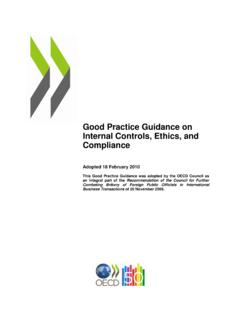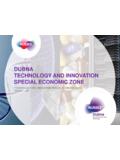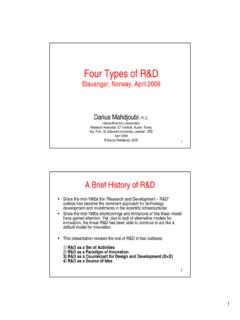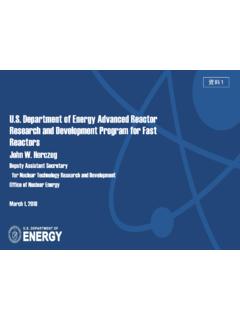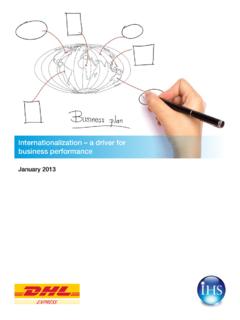Transcription of Large Research Infrastructures - OECD.org
1 OECD Global Science ForumOECD Global Science ForumLarge Research Infrastructures Report on Roadmapping of Large Research Infrastructures (2008)Report on Establishing Large International Research Infrastructures : Issues and Options(2010)w w w. o e c d . s t i / g s fPhoto front cover : Canada-France-Hawaii Telescope / Cuillandre Large Research InfrastructuresForward Ever since the creation of the OECD Megascience Forum in 1992, Large Research Infrastructures have been a major topic for analysis and discussion at the Organisation for economic Co-operation and Development.
2 This did not change when the Megascience Forum received a new name and a new, enlarged mandate in 1999, becoming the Global Science Forum (GSF). Like its predecessor, the GSF is a committee whose members are senior science policy officials of the governments of the OECD countries. Two types of activities have been undertaken over the years: strategic foresight in specific scientific disciplines, and generic policy studies that provide useful advice about Research Infrastructures , based on past experiences and current requirements. In all cases, the GSF s activities have involved not just government officials, but also administrators of Research institutes, representatives of various scientific unions and advisory committees, as well as prominent individual researchers.
3 The work has been organised, managed and assisted by a small secretariat of international civil servants, based at OECD headquarters in Paris. Among the scientific domains that have been the subject of the first type of GSF activity are nuclear physics, high-energy physics, astronomy and astrophysics, radio astronomy, the study of condensed matter, neutron science, high-intensity lasers, proton accelerator-based facilities, structural genomics, grid computing and, most recently, astroparticle physics. In each case, the scientific imperatives were listed, and desired generic measurement capabilities were enumerated along with the main technical challenges.
4 Finally, opportunities for international collaboration and coordination were identified, especially for those anticipated experimental efforts where the size, complexity and cost of future Infrastructures are likely to make international cooperation a necessity. The two reports that are contained in this publication are instances of the second type of GSF activity. They pertain, respectively, to two important phases in the realisation of Large Research Infrastructures : systematic strategic planning (also known as roadmapping) and the process of establishing a new international infrastructure.
5 In both cases, the GSF s objective was not to carry out an exhaustive, academic, theoretical study based on a universal intellectual framework that would be valid in all cases and at all times. Instead, the goal was to provide useful information and advice to scientists and policymakers who are faced with very specific, practical challenges related to future Research programmes: planning ahead for a series of significant investments in Infrastructures , or bringing several countries together to jointly implement a Large Research facility. To reach its objective, the GSF adopted a down-to-earth, empirical methodology: a systematic critical review of existing roadmap documents, and a series of confidential interviews with persons who have gone through the difficult task of establishing a big international collaboration.
6 In putting these reports into the hands of scientists and administrators, we are aware of the fact that not all of their concerns will be addressed, and not all of their questions will be answered. Each major planning or implementation effort is, to some extent, sui generis. Accordingly, the OECD reports are essentially a compendium of issues that should be considered, and of solutions that have been found to be applicable in certain cases. We sincerely hope that the reports will be informative and useful: making collaborative projects run more smoothly, helping to avoid misunderstandings, disputes and delays.
7 Naturally, we would be interested in receiving comments and corrections from readers. The GSF staff can be reached at Hermann-Friedrich Wagner Chairman, Global Science Forum, 2004-2010 Stefan Michalowski Executive Secretary, Global Science Forum Page 1 of 18 Organisation for economic Co-operation and Development (OECD) Global Science Forum Report on Roadmapping of Large Research Infrastructures December 2008 Based on the Workshop on Enhancing the Utility and Policy Relevance of Roadmaps of Large Research Infrastructures held in Bologna, Italy, on June 10/11, 2008 Contents page 1 Introduction and background 1 2 The diversity of infrastructure roadmaps 3 3 The significance and impacts of roadmaps 6 4 Caveats 7 5 The roadmapping process 8 5a Customers.
8 Performers and procedures 9 5b Science cases 11 5c Costs of Infrastructures 12 5d International considerations 13 6 Summary of main points and conclusions 13 7 Appendices 15 1 Introduction and background In various fields of science, policy-makers among them delegates to the OECD Global Science Forum face decisions about the planning, funding and implementation of Large Research Infrastructures . They must take into consideration the priorities and requirements of many scientific communities, the international context, and the priorities of society in general.
9 As an aid to the decision-making process, they are increasingly making use of strategic, long-range planning exercises, and of the resulting documents which are often called roadmaps . The generic issues associated with infrastructure roadmapping were discussed by the delegates to the Global Science Forum during several bi-annual GSF meetings but, to address the topic more systematically and to produce a more concrete outcome, the GSF agreed to convene a two-day workshop that would bring together science funding agency officials, roadmap practitioners and members of the scientific community.
10 Page 2 of 18 The goal of the workshop was to explore ways of maximising the utility of roadmaps, , of ensuring that the process, and the findings and recommendations contained in the roadmaps, respond to the actual needs of the policymakers. Specifically, the objectives were to: better understand the needs of the policymakers, to identify common issues, questions, and good practices in the preparation of roadmaps; assist those who are currently undertaking the preparation of new roadmaps, or the updating of existing ones; share experiences and information, and strengthen contacts between the stakeholders.









